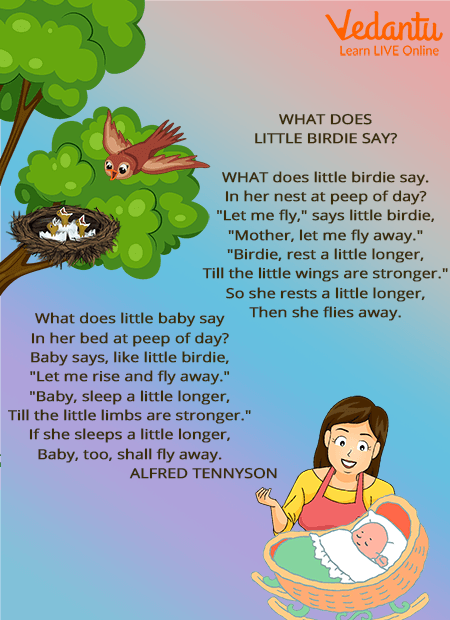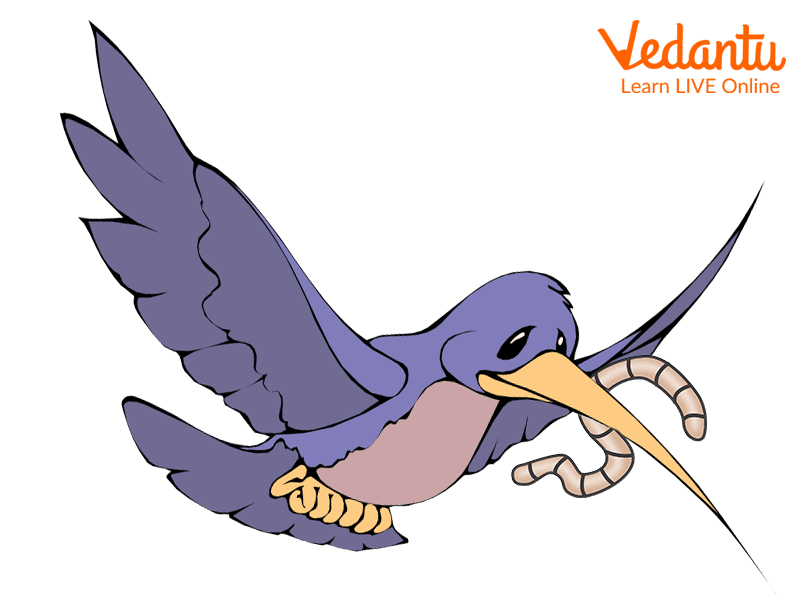Easy Kids Poems on Birds in English
Have you ever watched birds chirping away in the morning? Do you wonder what do the birds tell when they chirp? You must have noticed local birds, maybe a sparrow, a crow, or a duck, at your window, on the branches of trees, or in a lake. Most birds symbolise joy, peace, freedom, and love. The cuckoo birds are considered the harbingers of spring, while the doves symbolise peace. Many great poets had been mesmerised by these beautiful creatures of nature and their mindless chirpings encouraged the poets to create some classic poems.
Here are a few amazing poems on birds that kids will enjoy reading.
What Does Little Birdie Say?
What does little birdie say
In her nest at peep of day?
“Let me fly,” says little birdie,
“Mother, let me fly away.”
“Birdie, rest a little longer,
Till the little wings are stronger.”
So she rests a little longer,
Then she flies away.
What does little baby say,
In her bed at peep of day?
Baby says, like little birdie,
“Let me rise and fly away.”
“Baby sleep, a little longer,
Till the little limbs are stronger.”
If she sleeps a little longer,
Baby too shall fly away.
- Alfred Lord Tennyson

‘What Does Little Birdie Say’
Summary
The poet talks about a little bird and a little baby in this poem. The little bird wanted to fly away. So when she woke up in the morning, she asked her mother if she could fly away from her nest. The mother bird told her to wait a little longer and rest at her nest, as her wings were not strong enough to fly. The little bird listens to her mother and rests for some days, then she flies away and never comes back.
In the second stanza, the poet introduces a baby who wanted to fly away just the same way as the baby. She asked her mother if she could rise from her bed and fly away. Her mother told her to sleep for some more time as her limbs were not strong enough to walk. The poet says if the baby sleeps some more, she will also fly away like the little birdie. The poem puts light on the fact that children, just like birds, leave their nests when they grow up, to go and explore the world. So, we should make the most of the time we have with our little ones when they are with us.
A Bird Came Down the Walk
A bird came down the walk;
He did not know I saw;
He bit an angle-worm in halves
And ate the fellow, raw.
And then he drank a dew
From a convenient grass,
And then hopped sidewise to the wall
To let a beetle pass.
He glanced with rapid eyes
That hurried all abroad,-
They looked like frightened beads, I thought
He stirred his velvet head
Like one in danger; Cautious,
I offered him a crumb,
And he unrolled his feathers
And rowed him softer home
Than oars divide the ocean,
Too silver for a seam,
Or butterflies, off banks of noon,
Leap plashless, as they swim.
- Emily Dickinson

A bird picking up worms
Summary
The poetess describes a bird that came down the walk, in this poem. She observed each move of the bird, but she was at such a distance from it, that the bird was not frightened by her. The bird picked up an ‘angle worm’ and devoured it in halves. Then the bird drank up some dew from a blade of grass. Then came a beetle in its way and the bird hopped aside to let it crawl past.
The poetess notices the bird closely and observes that it is anxious. The bird watched with rapid eyes, attempting to see everything at once. It means that the bird was quite aware of the dangers it might face. The poetess describes the bird’s eyes as frightened beads, shiny, nearly black, rolling from one side to the other. Then the bird moved its head that looked velvety with its feathers. It might be a little scared of the poetess looking at it. Then the poetess attempted to interact with the bird, so she offered it a crumb of food. The bird did not eat the crumb. It unrolled its feathers, that is, opened its wings, and took off to flight.
The poetess uses beautiful metaphors to describe the departure of the bird to its home. She draws a fine comparison between its flight and sailing through the ocean. The wings of the bird moving through the air are compared to the oars that move through the waters. She imagines it as if the wings of the bird divide the blue sky as the oars seem to divide the water. The velvety bird is compared to a butterfly taking off from the banks at noon, in the heat of the day. The butterflies move through the air, splashless as if they were swimming through water.
Conclusion
Each poem on birds for kids given above provides the young readers an opportunity to correlate some beautiful aspects of nature. The first poem draws a comparison between a little bird and a baby, stating how they both want to go out into the world, leaving their nests behind. While the second poem opens up a window to the simple yet beautiful movements of a bird in nature. There are many other poems on birds for kids, reading which kids can learn various things in the disguise of beautiful poetic devices. So let your child unfold all they can with each poem on birds for kids and explore nature in their own way.


FAQs on English Poems on Birds for Kids
1. Name five classic poems on birds.
The following are the five classic poems on birds.
The Skylark
To the Cuckoo
Ode to a Nightingale
Pigeons
The Windhover
2. What similarities does Alfred Lord Tennyson strike between the baby and the bird in the poem ‘What Does Little Birdie Say?’?
In the poem, What Does Little Birdie Say, the poet portrays a beautiful similarity between the baby and the bird. The young bird, in this poem, wants to fly away and see the world and so does the baby. The baby also wants to rise from its bed and fly out to behold the world, just like the young. They both are lured by the intriguing mystery of the world unseen. The young bird and the baby seem to be oblivious to the feeling of leaving home behind, while their mothers ask them to stay put till they grow up.





